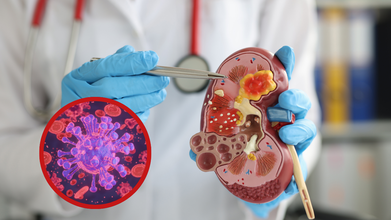- Health Conditions A-Z
- Health & Wellness
- Nutrition
- Fitness
- Health News
- Ayurveda
- Videos
- Medicine A-Z
- Parenting
- Web Stories
Skincare Expert Says Begin Your Teenager's First Skincare Routine With This Habit To Stay Acne-Free

Image Credit: Canva
As a teen the biggest problem is the struggle with breakouts, oily skin, and stubborn acne! Teenage skin changes dramatically, and without a good skincare routine, those annoying zits and pimples can linger. But we have some good news: we're about to share with you a super easy daily habit that can keep your skin clear and radiant.
Incorporating skincare routines into daily lives does not only enhance skin wellness but also educates adolescents on the importance of self-preservation and cleanliness. When adolescents know how their skin type works and what it needs, they feel better about themselves. This enhances self-confidence and urges them to do more for their health in general.
According to skincare specialist Abolee Chandrayan, developing the right habits in the teenage years is important to keep skin clear and healthy. "Teenage years are a big transition from soft baby skin to a more mature skin texture. Because of hormonal changes, teens tend to have acne, oiliness, or dryness. Having a good skincare routine during this time prevents long-term skin problems and encourages radiant skin," says Chandrayan.
What Causes Teenage Acne?
As one ages, hormone levels fluctuate, and the skin responds to this. Teenage acne is commonly fueled by overproduction of oil caused by hormonal changes. Other factors like genetics, stress, and comedogenic cosmetics may also play a part in causing pimples.
Common Forms of Teenage Acne
Whiteheads: Tiny, flesh-colored or white bumps formed due to the plugging up and closing of pores.
Blackheads: Blackheads are not due to dirt, contrary to popular belief, but to open pores that get clogged and oxidized.
Papules and Pustules: They manifest as tiny, red bumps (papules) or pus-filled spots (pustules) popularly known as pimples.
Nodules and Cysts: Severe forms of acne that form deep in the skin, which may need dermatological intervention due to inflammation and pain.
Why Skincare Is Essential for Teens?
Teen skin is very sensitive caused by over-production of oil, pollution exposure, and hormonal surges. "A well-formulated skincare regime not only aids in controlling acne but also promises long-term well-being of the skin. Teaching teenagers the benefits of skincare in early life is important," suggests Chandrayan.
Adolescents with combination or oily skin tend to develop enlarged pores and blackheads, whereas dry and sensitive skin-prone teenagers suffer from sensitivity against chemicals and sunlight. It thus becomes absolutely crucial to use appropriate skincare products in accordance with one's own skin requirements.
The 3-Step Teen Skincare Routine
A teen's skincare routine should ideally comprise three elementary steps to provide a strong basis for achieving clean skin.
1. Cleansing
"Cleansing is the initial and most important step towards having healthy skin. Teenagers must wash their face twice a day with a mild cleanser appropriate to their skin type," recommends Chandrayan. A good cleanser cleanses away dirt, oil, and grime without causing breakouts. Sulfate-free and non-comedogenic formulas are best to keep them away from excess dryness and irritation.
2. Moisturizing
Daily application of a moisturizer is crucial, even for oily skin. "Many adolescents avoid moisturizers in fear that they will aggravate acne, but the right moisturizer will rebalance oil production and keep the skin barrier healthy," says Chandrayan. Oily or acne skin teens should use light, oil-free, and non-comedogenic moisturizers, whereas those with dry skin need to use a hydrating product containing ceramides or hyaluronic acid.
3. Sun Protection
Sunscreen is an essential skincare product, irrespective of skin type. "Sun protection is not negotiable for teenagers," opines Chandrayan. "Applying SPF 30 or more on a daily basis—irrespective of weather conditions—prevents premature aging, hyperpigmentation, and skin damage due to UV radiation." Oily skin teenagers must use a matte, oil-free sunscreen to prevent greasiness.
Adolescents must avoid applying random or extremely harsh skin care products. They should, instead, use dermatologist-tested formulas containing gentle, plant-based ingredients. "A COSMOS-certified organic skin care brand with willow bark and basil as its ingredients can gently cleanse and care for the skin without harming the environment and animals," advises Chandrayan.
Long-Term Habits for Healthy Skin
Skincare is not all about products—it's about lifestyle choices. "What you eat also has a major impact on the health of your skin. If you're eating a lot of processed foods and refined sugars, it can worsen acne," Chandrayan cautions. "Teenagers should have an omega-3 fatty acid-rich diet with plenty of fruits and vegetables and hydrate with plenty of water to keep them well-hydrated."
Other than skincare products, consistency is the way to go. "Results won't show overnight. Skincare is a long-term process, and having a routine with discipline is important," Chandrayan suggests.
Mr Abolee Chandrayan is a Skincare Expert and Head of Research & Development at Puddles in India
Why Allergies Are Almost Nonexistent In Children From THIS Community

(Credit-Canva)
One of the many beliefs that people hold, especially the older generation, is that the new way of living, which is highly protected and sanitized, has made kids weaker. While there are certain evolutionary changes we have developed over the past few centuries, it is arguable whether we are . However, their theory may not be far from the truth, but how do we know that? To this day, there are certain communities who enjoy a quiet living, void of modern possessions like the Amish community.
Surveys have noted that Amish children tend to have lesser allergies or asthma cases, but how?
Why Do Amish Children Have Less Allergies?
Scientists have long known that kids who grow up on traditional farms are less likely to have asthma and allergies. This is called the "farm effect," and it seems to be caused by being around farm animals, especially cows, and the microbes (tiny living things) that are found there.
In a 2018 study, researchers from The University of Manchester and Northern Care Alliance NHS Foundation Trust studied two unique farming communities in the U.S.: the Amish and the Hutterites. Both groups have similar genes and lifestyles, but they farm in very different ways, and this seems to be the reason for their different health outcomes.
Another 2020 study done by the American College of Allergy Asthma & Immunology compared the living of Amish and Old Order Mennonite, who also have a similar style of living, with a few comparable changes.
What Is The Difference Between Amish And Hutterite Living?
The Amish and Hutterites both came from the same group in Europe and have similar lifestyles. They eat similar foods, have large families, and avoid many modern habits like having indoor pets or using the internet. However, their farming practices are completely different.
Amish Farms
The Amish use old-fashioned, family-run farms with horses for work. Their barns are close to their homes, so children are around the animals and barn dust from a young age.
Hutterite Farms
The Hutterites live on large, modern, industrial farms. Their barns are big and located far from their homes, so children have little contact with the animals or barn environment.
This difference in lifestyle led to a major difference in health. The study found that Amish children have a very low rate of asthma (just 5.2%), while Hutterite children have a much higher rate (21.3%). This shows that the environment, not their genes, is the most important factor in preventing asthma.

How Was Amish Health Different From Mennonite Health?
The 2020 study researchers created a survey to compare the health of these two groups. They asked families about different types of allergies they had, as well as their lifestyle and farming practices.
They found that families in both groups lived on farms and drank raw, unprocessed milk. However, the Amish families had more children on average and lived on smaller farms with fewer animals compared to the Mennonite families. The survey results showed a significant difference in health between the two groups:
The Amish families reported having a much lower rate of allergies overall. Only about 26% of Amish households had a family member with an allergy.
The Mennonite families had a much higher rate of allergies, with nearly 47% of households reporting an allergy.
Why Were The Amish Less Likely To Get Allergies?
One key difference is that while both the Amish and Mennonites have large families, Mennonite communities sometimes use modern technology like tractors and electricity. In contrast, the Amish stick to traditional, old-fashioned farming.
This difference in farming methods could change the types of microbes (tiny living things) found in the farm environment. Since other research has shown that these specific microbes are important for preventing allergies, the different farming practices might explain why the Amish have a much lower allergy rate.

How the Environment Protects Against Asthma
The scientists found a key difference in the homes of the two groups: Amish homes had much more endotoxin, a type of dust from bacteria. When this dust was tested on mice, the dust from Amish homes protected the mice from developing asthma. However, dust from Hutterite homes actually made the mice's asthma worse.
This suggests that the kind of dust and microbes you are exposed to matters. The dust in Amish homes is full of "good" microbes that help a child’s immune system grow and develop correctly, preventing it from overreacting and causing asthma.
How Does Immunity Affect Allergies And Asthma?
The study also looked at the children's blood and immune systems. They found that the Amish children’s immune systems were very different from the Hutterite children's. The Amish kids had a stronger innate immune system, which is the body's first defense against germs. Their immune cells were "calm" and seemed to be trained to not overreact to things that can trigger asthma.
This research strongly suggests that the farm effect works by "training" the immune system. Early exposure to a wide variety of microbes helps the body learn how to respond correctly, which in turn protects against asthma.
While these studies give us a lot of great information, there are still many questions to answer. Scientists still need to figure out exactly which microbes or substances in the farm environment are the most protective. They also need to study children at a younger age to see how their immune systems change over time.
But for now, the findings from this research confirm that growing up on a traditional farm and being exposed to its rich environment is a powerful way to protect against asthma and allergies.
Chronic Kidney Disease Could Be Predicted With The Help Of Biological Markers, Research Finds

(Credit-Canva)
Chronic kidney disease (CKD) affects about 37 million people in the United States and approximately 90% do not even know they have it (National Kidney Foundation). Despite its global relevance, we still have no cure for it and its treatment usually consists of managing the symptoms to slow down the progress of the disease. However, a new discovery may have changed these odds.
Scientists from The University of Manchester and Northern Care Alliance NHS Foundation Trust have made a big discovery that could change how we treat CKD. They have found new ways to predict how the disease will get worse, which could lead to a simple blood or urine test for patients.
In a recent study published in the American Journal of Nephrology, researchers found that a special marker called Kidney Injury Molecule-1 (KIM-1) can predict a patient's risk of both kidney failure and death. This is the first time these two factors have been measured together, giving doctors a much better understanding of a patient's overall risk.
What Is Chronic Kidney Disease?
Your kidneys are vital organs that do many important jobs to keep your body healthy. They act like a filter, removing waste and extra water. They also help control your blood pressure, keep your bones healthy, and help your body make red blood cells.
Chronic kidney disease (CKD) happens when your kidneys are damaged over a long period (at least three months) and can't do these important jobs well. Because it develops slowly, CKD also raises your risk of other health problems, like heart disease and stroke. Doctors divide CKD into five stages to help guide treatment.
What Makes This Discovery So Important?
Right now, doctors find it hard to predict how CKD will progress because it can be very different for each person. One patient's condition might stay stable for years, while another's might suddenly get worse. The standard tests used today don’t give a full picture, often missing important clues like inflammation. This means patients with the same disease stage often get the same treatment, even if their risk levels are completely different.
This new research helps doctors see the "hidden drivers" of the diseasey—the actual biological changes happening inside the body. Dr. Thomas McDonnell, the lead researcher, said that these findings could lead to a more personalized approach to care.
How This Could Help Patients
With this new information, doctors would be able to:
Help high-risk patients sooner
Doctors could identify patients who are most likely to get worse and start more aggressive treatments earlier, which could make a big difference in their health.
Avoid unnecessary treatments
For patients at a low risk, doctors could prevent them from getting over-treated, which means fewer medical appointments and less stress.
Living with CKD can be tough, but this new discovery offers hope for better, more targeted care. By giving doctors a clearer look at each patient's individual risk, it could help people with chronic kidney disease live more active and fulfilling lives.
What Are The Signs And Symptoms Of CKD?
Many people with CKD don't notice any symptoms until the disease is in its later stages. When symptoms do appear, they can include:
- Foamy urine, or urinating more or less often than usual
- Itchy, dry skin
- Feeling very tired
- Nausea or loss of appetite
- Weight loss without trying
In more advanced stages of CKD, you might also experience:
- Trouble thinking clearly
- Swelling or numbness in your arms, legs, or feet
- Achy muscles or cramps
- Shortness of breath
- Vomiting
- Trouble sleeping
- Breath that smells like ammonia (or a "fishy" smell)
High Blood Pressure And Cognitive Decline Strongly Linked - New American Heart Association Guidelines States

The American Heart Association (AHA) has updated its official recommendations for dealing with high blood pressure, replacing the old rules from 2017. These new guidelines are the result of a deep look into the latest research, providing doctors and patients with better information on how to understand, prevent, and treat high blood pressure. They are designed to be a clearer, more effective guide for everyone.
High blood pressure is one of the biggest silent killers globally. Although many people suffer from it, most do not make the necessary changes to ensure that their health doesn’t deteriorate. A global estimate of about 1.28 billion adults aged 30-79 years has hypertension, according to the World Health Organizations (WHO). It is also estimated that 46% of these people are unaware that they have the condition.
To ensure that people keep their health in check, government and health institutions issue health guidelines that help people take care of their health.
What Are The Latest Changes To High Blood Pressure Guidelines?
The new guidelines highlight several key points:
Brain Health
There is now stronger evidence linking high blood pressure to an increased risk of cognitive decline and dementia. Managing your blood pressure now may help protect your brain in the future.
Leading Risk Factor
High blood pressure remains the top risk factor for serious health problems like stroke, coronary artery disease, heart failure, and AFib.
Pregnancy-Related Hypertension
The new guidelines feature specific blood pressure categories for pregnant individuals to help detect serious risks, such as preeclampsia. Regular blood pressure checks are now considered crucial. It's important for expectant mothers to monitor their blood pressure closely before, during, and after pregnancy to ensure their health and the safety of their baby.
- Normal blood pressure is when your top number is less than 140 and your bottom number is less than 90.
- Hypertension in pregnancy is when your top number is 140 or higher, or your bottom number is 90 or higher.
- Severe hypertension is when your top number is 160 or higher, or your bottom number is 110 or higher.
Tips for Managing Your Blood Pressure
You can take steps to manage or prevent high blood pressure through a combination of lifestyle changes and, if needed, medication. For the most accurate reading, sit with your back supported, feet flat on the floor, and arm extended at heart level.
Dietary Changes
- Aim for less than 2,300 mg of sodium per day (about one teaspoon of salt). The ideal goal is less than 1,500 mg.
- Follow a heart-healthy diet like the DASH eating plan, which focuses on fruits, vegetables, whole grains, nuts, and low-fat dairy.
- Drinking less or no alcohol can help lower your blood pressure.
- Losing even a small amount of weight (at least 5% of your body weight) can help lower blood pressure. For example, if you weigh 180 pounds, losing just 9 pounds can make a difference.
- Activities like meditation, controlled breathing, or yoga can help.
- Ask your healthcare professional about other conditions that can cause high blood pressure, such as sleep apnea, diabetes, and thyroid problems.
What Does General Blood Pressure Look Like?
It's important for everyone to understand their blood pressure numbers. The new guidelines classify blood pressure into these categories:
Normal: Your top number is less than 120 and your bottom number is less than 80.
Elevated: Your top number is between 120 and 129, and your bottom number is less than 80.
Stage 1 Hypertension: Your top number is between 130 and 139, or your bottom number is between 80 and 89.
Stage 2 Hypertension: Your top number is 140 or higher, or your bottom number is 90 or higher.
A hypertensive crisis is a medical emergency that occurs when your blood pressure is higher than 180/120. If your blood pressure reaches this level and you have symptoms like chest pain, shortness of breath, or numbness, you should call emergency services. If you need a health and diet guide, you can follow the ‘Life’s Essential 8’, the guideline that helps keep our health a priority by the American Heart Association.
© 2024 Bennett, Coleman & Company Limited

